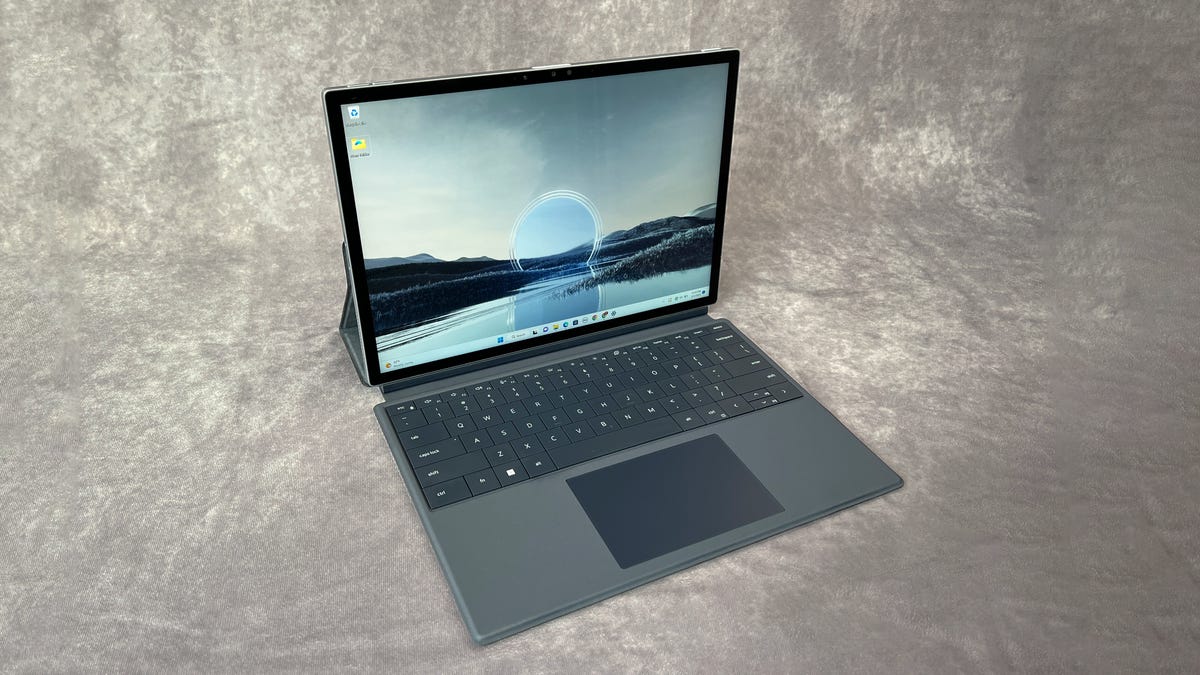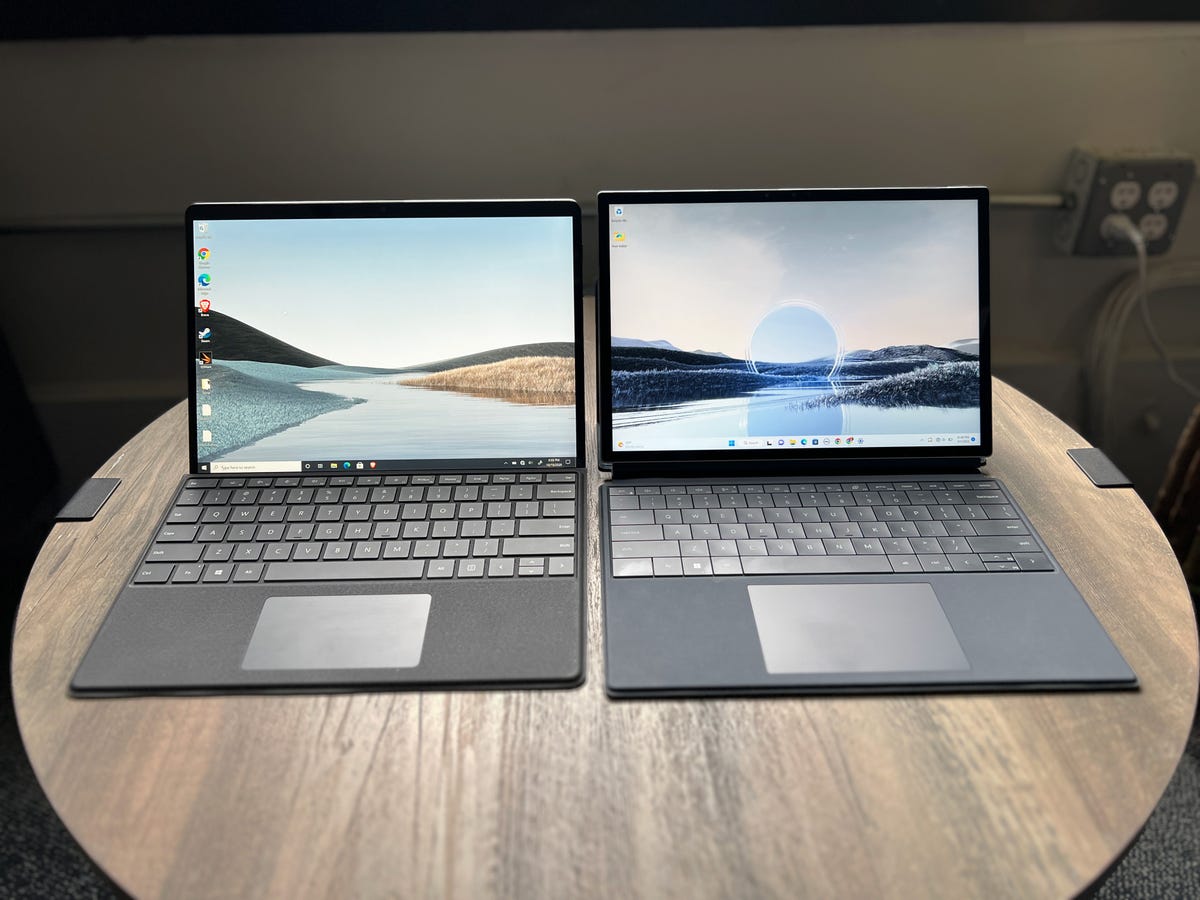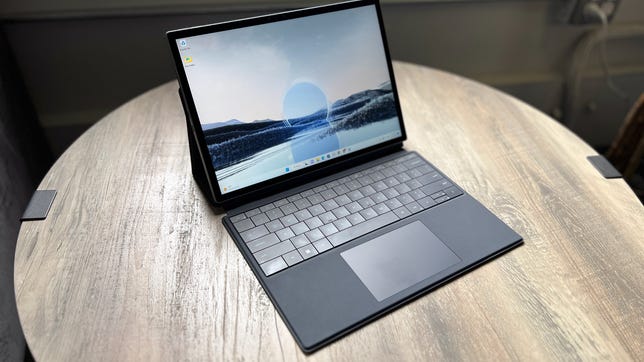Technologies
Dell XPS 13 2-in-1 Review: A Surface-like Slate for Less
The latest hybrid XPS isn’t as expensive as the Microsoft Surface it apes, but parts of it aren’t as good, either.

The newest XPS 13 two-in-one from Dell looks and feels a lot like the Surface Pro from Microsoft. Yes, there are many other Windows tablets with clip-on keyboards, but the Surface is the original and still best known, so it’s the one you’re most likely to compare with this.
I’ve always been a fan of the XPS line in general, and specifically the XPS 13 clamshell laptops. This two-in-oneversion has some of the same aesthetically minimalist touches and mod-feeling matte aluminum body. Even better, it costs a good deal less than a comparable Surface Pro, depending on how you configure each system.
Like
- Less expensive than some competing products
- Fanless, silent operation
- Excellent keyboard feel
Don’t Like
- Kickstand implementation is poor
- Keyboard lies perfectly flat
- No headphone jack
A Surface Pro 9 with a Core i5 CPU, 16GB of RAM and a 256GB SSD, along with the keyboard cover, is $1,578. A similarly configured XPS 13 two-in-one, also with the keyboard cover, is $1,299. And that’s with a bigger 512GB SSD, too. An exact comparison is tough because the Surface Pro 9 doesn’t offer a pairing of Core i5 and 512GB, while the XPS 13 two-in-oneoffers only 512GB and 1TB storage options. Prices can also change regularly with limited time discounts and deals. (As of this review, the Surface Pro 9 is offering a free keyboard cover for a limited time, a savings of $179.)
There’s also an ARM-based Surface Pro 9 (the model we reviewed) that uses Microsoft’s SQ3 chip instead of one from Intel and adds 5G support, but there’s no comparable XPS two-in-oneoption for that.
Dell XPS 13 9315 2-in-1
| Price as reviewed | $1,299 |
|---|---|
| Display size/resolution | 13-inch 2,880×1,920 Touch |
| CPU | 1GHz Intel Core i5-1230 |
| Memory | 16GB LP-DDR4 |
| Graphics | 128MB Intel Iris Xe Graphics |
| Storage | 512GB, M.2, PCIe NVMe, SSD |
| Networking | Wi-Fi 6E 1675 (AX211) 2×2 + Bluetooth 5.2 |
Keyboard and kickstand sins
But configured as closely as possible, there’s a pretty big price difference. Still, I’m still not sure I would go with the XPS two-in-oneover the Surface Pro 9. Why? Because the two things the Surface has perfected about tablet/laptop hybrids, the kickstand and the keyboard cover, are not quite as perfected here.


And that’s a shame because the 13-inch 2,880×1,920 screen is bright and rich-looking. It’s rated for 500 nits brightness, and in practice it makes for a very good TV/movie streaming device when lying in bed. The Surface Pro supports a faster 120Hz refresh rate, versus just 60Hz here. That can mean smoother video, but also have an impact on battery life. Having a higher, or variable, refresh rate is a nice feature to have, but most people will be happy with a 60Hz screen.
But the keyboard cover, which Dell calls the XPS Folio, is a letdown. I’ll start with the good news: It’s just $100 extra, not the criminal $179 Microsoft charges for its keyboard cover. But unlike the Surface keyboard, which can angle up at the back for a more ergonomic experience, the Dell version sits flat on your desk and that’s it. The actual keys are large, flat, edge-to-edge-style keys, which is a good use of limited space, and in fact, it feels more like a solid laptop keyboard than the Surface version. But, the lack of any kind of incline option made it feel awkward.


A far bigger sin is how the kickstand is incorporated into the XPS Folio itself, instead of being built into the tablet. That means to prop up the XPs 13 two-in-one, you need the full keyboard cover attached, even if you just want to prop the tablet up like a standalone screen. While the Surface Pro allows for almost unlimited kickstand angles, the back of the XPs Folio slides down into three magnetic stops, and it’s entirely possible none of them will feel exactly right to you.
Fanless performance
Once you get past these design foibles, the XPs 13 two-in-oneis a respectable performer for a U-series Core i5 Windows system. It’s fanless, which makes it totally silent and helps battery life, even if it’s a theoretical limiter on overall performance because the heat needs to be regulated.
A current M2 MacBook is faster, as is the Core i7 XPS 13 Plus and the most recent Core i5 XPS 13, but not by a huge amount. I’d call this a perfectly fine PC for mainstream tasks and even some photo or video work.


Battery life is also nearly 7.5 hours on our online video streaming test. Again, nowhere near what some other laptops with bigger batteries can pull off, but still very good if you’re going to be doing a lot of video streaming.
This see-sawing list of pluses and minuses leave the XPS 13 two-in-onein a strange place. The price is right, considering the components, accessories, design and performance. But in some of the quality of life issues, it falls behind the more expensive Surface Pro line, and you’ll have to decide if the price tradeoff is worth it for the kickstand and keyboard differences.
Geekbench 5 (multicore)
Note:
Longer bars indicate better performance
Cinebench R23 (multicore)
Note:
Longer bars indicate better performance
Online streaming battery drain test
Note:
Longer bars indicate better performance
System configurations
| Dell XPS 13 9315 2-in-1 | Microsoft Windows 11 Home; 1GHz Intel Core i5-1230U; 16GB DDR4 4,266MHz RAM; 128MB Intel Iris Xe Graphics; 512GB SSD |
|---|---|
| Dell XPS 13 9315 | Windows 11 Home; 1GHz Intel Core i5-1230U; 16GB DDR5 6,400MHz RAM; 128MB Intel Iris Xe Graphics; 512GB SSD |
| Dell XPS 13 Plus 9320 | Windows 11 Home; 1.8GHz Intel Core i7-1280P; 16GB DDR5 6,400MHz RAM; 128MB Intel Iris Xe Graphics; 512GB SSD |
| Microsoft Surface Pro 9 | Microsoft Windows 11 Home; 3GHz Microsoft SQ3; 16GB DDR4 RAM; 7,889MB shared Qualcomm Adreno graphics; 256GB SSD |
| Microsoft Surface Pro 8 | Microsoft Windows 11 Home; 3GHz Intel Core i7-118G7; 16GB DDR4 RAM; 128MB Intel Iris Xe graphics; 256GB SSD |
| Apple MacBook Air (13-inch, M2, 2022) | Apple MacOS Monterey 12.4; Apple M2 8-core chip; 8GB RAM; Apple 10-core GPU; 256GB SSD |
| Asus ROG Flow Z13 | Microsoft Windows 11 Home; 2.5GHz Intel Core i9-12900H; 16GB DDR5 6,400MHz RAM; 4GB Nvidia RTX 3050 Ti graphics; 1TB SSD |
The best laptops in every category
- Best Laptop for 2023
- Best Windows Laptops
- Best Laptop for College
- Best Laptop for High School Students
- Best Budget Laptop Under $500
- Best Dell Laptops
- Best 15-Inch Work and Gaming Laptops
- Best 2-in-1 Laptop
- Best HP Laptops
- Best Gaming Laptop
- Best Cheap Gaming Laptop Under $1,000
- Best Chromebook: 8 Chromebooks Starting at Under $300
Technologies
Las Vegas First Responders Lean on AT&T’s FirstNet to Stay Connected During the F1 Race
Amid the chaos of the Formula 1 Las Vegas Grand Prix, I talked to AT&T and first responders about how they plan and operate during events like this.

At the Formula 1 Las Vegas Grand Prix race, Rich Johnson can hear the distant percussive blats of the F1 cars racing in downtown Las Vegas, but he won’t get to see them all weekend. And he’s fine with that.
Although he’s in town specifically for the event, his main focus is ensuring that, in the event of any emergencies, first responders can communicate and coordinate effectively. I spent time with Johnson, the associate director of network disaster recovery for AT&T, to learn more about an important piece of the race weekend that most people won’t — and shouldn’t have to — think about.
Johnson oversees teams of people and resources strategically positioned around the race track and throughout the city as part of FirstNet, the First Responder Network Authority, «a private/public partnership between AT&T and the US government to create, maintain and service a nationwide public safety drop-in network,» he explains.
FirstNet operates on Band 14, a patch of spectrum dedicated for first responders so they don’t have to compete for a signal if something happens, even in a wireless-rich environment like a Formula 1 race.
«If our primary communication methods fail, we have backups that we can go to,» said Brian O’Neal, deputy fire chief with the Clark County Fire Department and emergency manager for Clark County. «Typically that involves moving from radio to cellular. When you look at an event like this, where a 3.8-mile track is running through the middle of the city, capacity within that system becomes a concern.»
That’s where FirstNet comes in, enabling every first responder to communicate with one another on that dedicated spectrum, which is not affected by all of the other competing signals.
As I spoke with O’Neal and Johnson, several bright yellow Clark County fire trucks rolled out behind them to be deployed throughout the area. Johnson pointed out that when the event is going on, traffic is even worse because it’s locked down, so ingress and egress is extremely difficult.
«All these fire trucks will end up being in that footprint before it gets locked out,» said Johnson. «And because we are so embedded with public safety, that’s part of the plan. We have our staff and equipment pre-staged throughout the footprint as well.»
One piece of equipment Johnson showed me was a small portable trailer that can be set up by a single person. When it’s activated, a process that takes about 30 minutes, it provides about a mile of FirstNet coverage.
It’s often towed by a larger response communications vehicle, which was also parked at the ready and has a deployable 20-foot mast that can provide cellular to first responders over about a mile-and-a-half radius.
Johnson also took me to the roof of a nearby parking garage, where a portable network tower occupied two parking spaces with a lovely view of downtown Las Vegas and the race track in the distance. It’s up there in «hot standby» mode as a backup to ensure a consistent flow of communication. If needed, it can be activated remotely in a few seconds, using a large dish to communicate with a long-range satellite as the data backhaul.
It’s unlikely the unit will be used during the weekend, but the commitment to multiple redundant systems is why it’s parked in the same spot as it was last year.
Planning for an event like this takes about six months, said Johnson, although much of it came together in four months this year because this is the third Las Vegas Grand Prix where FirstNet has been on hand. Both Johnson and O’Neal reiterated that the technologies and capabilities of these tools are used throughout the year for everyday operations, too. They’re just scaled up dramatically for a planned event like this.
Johnson said AT&T has over 190 assets like these dedicated to FirstNet, with access to over 750 AT&T assets they can use exclusively for public safety if needed.
Technologies
Pennies With Purpose: Smart and Simple Ways to Use the Disappearing Coin
The classic one-cent coin is being retired, but it still has purpose.

The penny — that lowly, grimy, circular piece of copper and zinc — is getting the last laugh. It’s been less than a month since the last one was minted on Nov. 12, and there are growing penny shortages all over the US. Stores are actually paying people to bring them in, and businesses fear they could lose millions of dollars.
What’s that old saying? You don’t miss something until it’s gone? Maybe the penny was more important than we thought. But that old one-cent coin had been fighting a losing battle for respect for years. You can’t buy anything with them anymore, not even a gumball. Most of us just toss them into a junk drawer or a glass jar. A sad penny can even lie on a sidewalk all day and not get scooped up.
Don’t miss any of our unbiased tech content and lab-based reviews. Add CNET as a preferred Google source.
The US Mint printed the last pennies on Nov. 12, ending a 230-year run. According to the Mint, the cost of making the coin was 3.69 cents for every one-cent penny — hardly a smart return on investment for taxpayers.
However, with the discontinuation of penny production, some brick-and-mortar businesses across the country have been unable to give back exact change because they lack sufficient pennies, if any at all.
A Retail Industry Leaders Association survey revealed that thousands of stores have no pennies, and they are calling on the federal government to take action.
Grocery chain Price Chopper and Market 32 recently held a Double Exchange Day, where people brought in their pennies and received double the value back in the form of a shopping voucher. Similarly, grocery chain Giant Eagle offered gift cards worth twice the amount of pennies customers brought in during a one-day event on Nov. 1.
Millions at stake
CBS News asked several large companies how they would handle cash transactions if there were shortages of pennies at the counter. McDonald’s said the company’s restaurants would round up or down to the nearest nickel, meaning an order costing $12.43 would round up to $12.45, but an order costing $12.42 would round down to $12.40.
Wendy’s, Kwik Trip, and GoTo Foods — parent company of Auntie Anne’s, Cinnabon, Jamba and Carvel — all said they would round down to the nearest nickel in favor of the customer. Kroger will encourage customers to use exact change, but still accepts pennies as payment.
Rounding down is beneficial for consumers, but the National Association of Convenience Stores estimates that thousands of stores across the US could collectively lose more than $1 million a day by rounding down. The NACS wants US lawmakers to create a law that would allow businesses to round transactions up to the nearest nickel.
Until the federal government establishes guidelines or regulations on how to address the disappearing penny, things will remain chaotic for a while.
Others have ditched the penny
Mark Stiving, CEO of pricing strategy company Impact Pricing, said the discontinuation of the penny will have «almost zero impact» on consumers and businesses in the long run. And he’s got the receipts from New Zealand to prove it.
«What I think is about to happen is that companies will still put prices out in ‘9’s (like $49.99),» Stiving told CNET. According to Striving, New Zealand used the rounding method after demonetizing and phasing out its penny. «You’d still price something at $9.99, but you just rounded it to the nearest nickel. So whenever a transaction happened, it was always the nearest nickel.»
Be penny-wise and take action
You’re not going to find a fortune by foraging all the pennies in your home, unless you have an exceptionally rare one lying around. But if you dig around your bedroom, garage, kitchen and even your car, you might collect a few bucks worth. That’s not nothing. Would you let a five-dollar bill collect dust in a drawer? Of course not.
Find a Coinstar kiosk. You’ve likely walked by one of the company’s 17,000 machines without even noticing it, but this is a pretty handy way to convert those pennies and other coins into cash. The process is simple: Locate a kiosk (typically found inside a grocery store) and deposit your coins to receive a cash voucher, which you can redeem at checkout or at customer service. There is a service fee of nearly 13%, so if you redeem $100 worth of coins, you’ll get $87.
Wrap the coins and find a bank: Many banks and credit unions will accept your coins. They might have a coin-counting machine, or they may ask you to organize the coins into wrappers, which is time-consuming but also will give you an idea of just how many coins you’ve been stashing. There may or may not be a fee, depending on whether you’re an account holder. (Note: Some banks will not accept prewrapped coins; they must be counted out or machine-checked to ensure they are legitimate.) Yes, people do hide same-weight slugs inside coin rolls.)
Just spend them: Gone are the days when you could ride your horse down to the general store and buy something with a penny, but there are still a few holdouts. Dollar General offers a weekly Penny List featuring out-of-season or discontinued items that have been marked down to just one cent. Websites such as The Krazy Koupon Lady and The Freebie Guy provide weekly updates on what you can get for a penny at Dollar General — if those items haven’t already been removed from the shelves. Krazy Koupon Lady even has a Home Depot hack where you can get items for a penny.
Find a collector’s item: It’s highly unlikely, but you never know. The most valuable penny is a 1943-D Lincoln Wheat Cent Penny, which could fetch nearly $2.5 million. Or perhaps you have an 1880 Indian Head Cent, which could net you around $150. USA Coin Book’s list of valuable pennies is here.
Fun and skills for kids: Those pennies could help you level up your arts and crafts toolbox. Help kids learn about budgeting, create some art, do a science experiment — you’ve got options! Check out Greenlight’s ideas.
Is the nickel next to go?
The penny is just the latest US coin to be discontinued. The half-cent, the half-dime, the large cent, the double eagle and several others have all come and gone.
The nickel could be next. It costs nearly 14 cents to make, almost three times the face value of the five-cent coin. The primary problem is that nickels are comprised of 75% copper and 25% nickel, metals which have doubled in price over the past decade.
But it will be tougher to eliminate the nickel than the penny. Rounding up or down to the nearest dime could cost US taxpayers $56 million per year, according to a study by the Federal Reserve Bank of Richmond. That is significantly more than the estimated $6 million rounding hit per year caused by the penny’s retirement.
A penny for your trivia
The penny may be vanishing, but its history is full of fun facts.
President Lincoln was not always on the penny. Honest Abe only became the star attraction in 1909, in honor of the 100th anniversary of his birth. Lady Liberty was the first to appear on the penny, back in 1793.
Newer pennies have little copper: Pennies minted after 1982 are made of copper-plated zinc, which consists of 97.5% zinc and 2.5% copper.
You can clean them: Vinegar, vegetable oil and water can help wash away decades of soot and grime off those pennies. But «don’t, don’t, don’t, don’t» even think about it if you want to hunt for any collectables in your penny stash — it could significantly damage their worth, says one coin shop owner.
Only Lincoln faces right: Our 13th president is the only person depicted on coins who is facing to the right. Everyone else faces left. Pull out some change and check for yourself.
50-50 coin toss? Try 80-20: Stanford math professor and former magician Persi Diaconis says that a penny will land tails up 80% of the time because the side with Lincoln’s head weighs significantly more than the tails side.
What D, S and P mean: Lettering on the front of the penny indicates where it was minted: D for Denver, S for San Francisco and P for Philadelphia. But you’ll only see P on pennies minted in 2017, which was done to celebrate the US Mint’s 225th anniversary. In all other years, pennies minted in Philly didn’t have the P.
Five special pennies: The final five pennies ever minted feature a special omega symbol, chosen because omega is the final letter in the Greek alphabet. You’re unlikely to ever see one in real life. Those five pennies will not enter circulation, according to the Treasury Department. Instead, the government plans to auction them off. Details about the auction aren’t yet available.
Technologies
How Much Tesla’s New Range of Affordable Electric Cars Cost, and What You Get
Here’s what you get with the stripped-down Model Y and Model 3.
-

 Technologies3 года ago
Technologies3 года agoTech Companies Need to Be Held Accountable for Security, Experts Say
-

 Technologies3 года ago
Technologies3 года agoBest Handheld Game Console in 2023
-

 Technologies3 года ago
Technologies3 года agoTighten Up Your VR Game With the Best Head Straps for Quest 2
-

 Technologies4 года ago
Technologies4 года agoBlack Friday 2021: The best deals on TVs, headphones, kitchenware, and more
-

 Technologies4 года ago
Technologies4 года agoVerum, Wickr and Threema: next generation secured messengers
-

 Technologies4 года ago
Technologies4 года agoGoogle to require vaccinations as Silicon Valley rethinks return-to-office policies
-

 Technologies4 года ago
Technologies4 года agoOlivia Harlan Dekker for Verum Messenger
-

 Technologies4 года ago
Technologies4 года agoiPhone 13 event: How to watch Apple’s big announcement tomorrow


